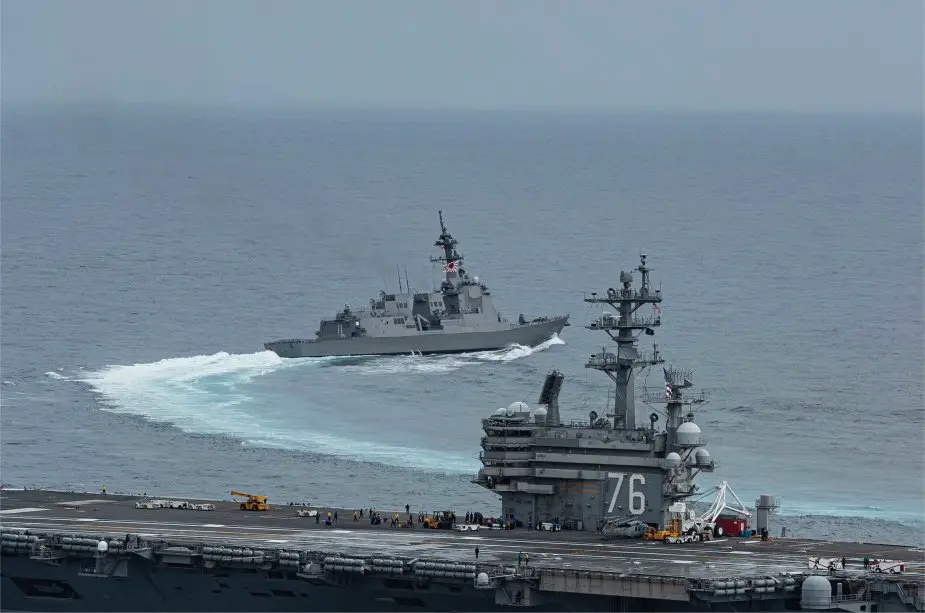Breaking news
USS Ronald Reagan CSG conducts exercise with JMSDF.
According to information published by the U.S. Navy on June 1, 2021, ships and aircraft from the USS Ronald Reagan (CVN 76) Carrier Strike Group (CSG) 5 and Japan Maritime Self-Defense Force (JMSDF) conducted integrated operations.
Follow Navy Recognition on Google News at this link
 USS Ronald Reagan aircraft carrier with guided-missile destroyer JS Maya (Picture source: Twitter account of Richships)
USS Ronald Reagan aircraft carrier with guided-missile destroyer JS Maya (Picture source: Twitter account of Richships)
In addition to aircraft carrier Ronald Reagan, CSG 5 consists of aircraft from the embarked Carrier Air Wing (CVW) 5, the Ticonderoga-class guided-missile cruiser USS Shiloh (CG 67), the Henry J. Kaiser-class underway replenishment oiler USNS Pecos (T-AO 197), and the Lewis and Clark-class dry cargo ship USNS Charles Drew (T-AKE 10).
CSG 5 operated in international waters with JMSDF’s Hyuga-class helicopter destroyer JS Ise (DDH 182) to exercise maritime maneuvers, strengthen the U.S.-Japan alliance, and improve regional security.
Routinely the Ronald Reagan CSG conducts a multitude of high-end warfighting exercises with JMSDF.
The strike group performed a publication exercise (PUB-EX), during which the watch standers of each ship quizzed each other on tactical and technical literature, and an anti-submarine warfare exercise involving a simulated contact. Shiloh and Japanese Ship Ise also performed cross-deck operations, exchanging helicopters between their flight decks, further demonstrating the compatibility of the two nations working alongside each other.
The U.S. Navy strives to take a cooperative approach to regional security and stability. The United States remains committed to protecting the rights, freedoms, and lawful uses of the sea, and the ability of all countries to exercise those rights. Together, the U.S. and its allies promote peace and prosperity by supporting international norms.
CSG 5 is deployed to the U.S. 7th Fleet area of operations in support of security and stability in the Indo-Pacific. U.S. 7th Fleet is the largest numbered fleet in the world, and with the help of 35 other maritime-nation allies and partners, the U.S. Navy has operated in the Indo-Pacific region for more than 70 years, providing credible, ready forces to help preserve peace and prevent conflict.
The squadrons that make up CVW-5 are the Strike Fighter Squadrons (VFA) 102, VFA-27, VFA-115, VFA-195, Electronic Attack Squadron (VAQ) 141, Fleet Logistics Support Squadron (VRC) 30, Helicopter Maritime Strike Squadron (HSM) 77, Helicopter Sea Combat Squadron (HSC) 12 and Early Warning Squadron (VAW) 125.
During their 2020 deployment, the Air Wing executed over 3,400 sorties and 11,000 flight hours while maintaining full combat readiness.
JS Ise (DDH-182) is a Hyūga-class helicopter destroyer of the Japan Maritime Self-Defense Force (JMSDF). It is the second ship to be named Ise, the first being the Imperial Japanese Navy World War II-era battleship Ise. The Hyūgas are primarily anti-submarine warfare carriers operating SH-60K anti-submarine helicopters. They also have enhanced command-and-control capabilities to serve as flagships.
The Hyūga-class helicopter destroyer has a length of 197 m, 13,950t flat-deck vessel that can carry up to four helicopters on deck and operate 18 helicopters including SH-60K Seahawk anti-submarine helicopter and MCH-101 airborne mine countermeasure helicopter. The ship has a crew of 340 sailors and can only carry helicopters.
The Hyūga-class helicopter destroyer armament includes 16 cells Mk 41 VLS 'Vertical Launching System) able to fire RIM-162 Evolved SeaSparrow Missile used to protect ships from attacking missiles and aircraft, 12 RUM-139 VL ASROC anti-submarine missile, two 20 mm Phalanx CIWS (Close-In Weapon Systems), two triple 324 mm torpedo tubes, and 12.7mm machine guns.





























